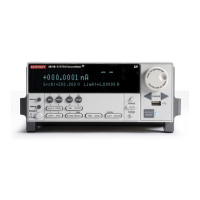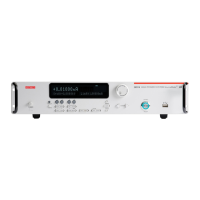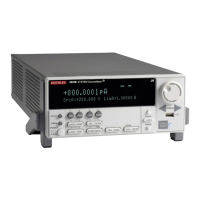2600S-901-01 Rev. C / January 2008 Return to Section Topics 12-41
Series 2600 System SourceMeter® Instruments Reference Manual Section 12: Instrument Control Library
localnode.linefreq
Attribute Power line frequency.
Usage frequency = localnode.linefreq Reads line frequency.
localnode.linefreq = frequency Writes line frequency.
frequency Set to 50 or 60.
Remarks • To achieve optimum noise rejection when performing measurements at integer NPLC
apertures, the line frequency setting must match the frequency (50Hz or 60Hz) of the AC
power line.
• When used in an expanded system (TSP-Link), localnode.linefreq is sent to the
remote master node only. Use node[N].linefreq (where N is the node number) to send
the command to any node in the system. See
Section 9 for details on TSP-Link.
• When this attribute is set, the localnode.autolinefreq attribute is
automatically set to false.
Also see localnode.autolinefreq
Example Sets the line frequency to 60Hz:
localnode.linefreq = 60
localnode.prompts
Attribute Prompting mode.
Usage prompting = localnode.prompts-- Reads prompting state.
localnode.prompts = prompting-- Writes prompting state.
prompting Set to 0 to disable or 1 to enable.
Remarks • This attribute controls prompting. When it is set to 1, prompts are issued after each
command message is processed by the instrument. When it is set to 0, prompts are not
issued.
• The command messages do not generate prompts. The Series 2600 generates prompts in
response to command messages.
• When the prompting mode is enabled, the Series 2600 generates prompts in response to
command messages. There are three prompts that might be returned:
•“TSP>” is the standard prompt. This prompt indicates that everything is normal and the
command is done processing.
•“TSP?” is issued if there are entries in the error queue when the prompt is issued. Like
the “TSP>” prompt, it indicates the command is done processing. It does not mean the
previous command generated an error, only that there are still errors in the queue when
the command was done processing.
•“>>>>” is the continuation prompt. This prompt is used when downloading scripts or flash
images. When downloading scripts or flash images, many command messages must be
sent as a unit. The continuation prompt indicates that the instrument is expecting more
messages as part of the current command.
• Test Script Builder (TSB) requires prompts. It sets the prompting mode automatically. If you
disable prompting, use of the TSB will freeze because it will be waiting for the prompt that
lets it know that the command is done executing. DO NOT disable prompting with the use of
the TSB.
• When used in an expanded system (TSP-Link), localnode.prompt is sent to the remote
master node only. Use node[N].prompt (where N is the node number) to send the
command to any node in the system. See Section 9 for details about TSP-Link.
Also see localnode.showerrors
Example Enables prompting:
localnode.prompts = 1

